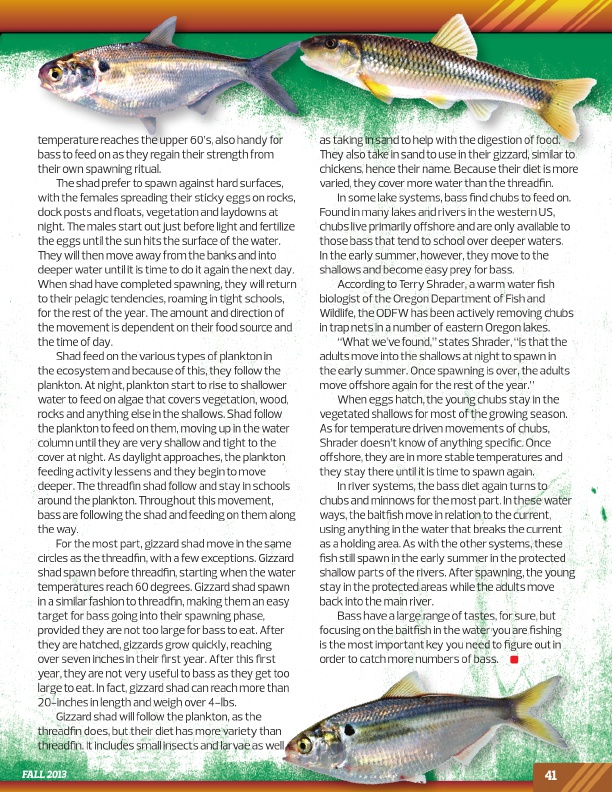
temperature reaches the upper 60’s, also handy for bass to feed on as they regain their strength from their own spawning ritual. The shad prefer to spawn against hard surfaces, with the females spreading their sticky eggs on rocks, dock posts and floats, vegetation and laydowns at night. The males start out just before light and fertilize the eggs until the sun hits the surface of the water. They will then move away from the banks and into deeper water until it is time to do it again the next day. When shad have completed spawning, they will return to their pelagic tendencies, roaming in tight schools, for the rest of the year. The amount and direction of the movement is dependent on their food source and the time of day. Shad feed on the various types of plankton in the ecosystem and because of this, they follow the plankton. at night, plankton start to rise to shallower water to feed on algae that covers vegetation, wood, rocks and anything else in the shallows. Shad follow the plankton to feed on them, moving up in the water column until they are very shallow and tight to the cover at night. as daylight approaches, the plankton feeding activity lessens and they begin to move deeper. The threadfin shad follow and stay in schools around the plankton. Throughout this movement, bass are following the shad and feeding on them along the way. For the most part, gizzard shad move in the same circles as the threadfin, with a few exceptions. Gizzard shad spawn before threadfin, starting when the water temperatures reach 60 degrees. Gizzard shad spawn in a similar fashion to threadfin, making them an easy target for bass going into their spawning phase, provided they are not too large for bass to eat. after they are hatched, gizzards grow quickly, reaching over seven inches in their first year. after this first year, they are not very useful to bass as they get too large to eat. in fact, gizzard shad can reach more than 20-inches in length and weigh over 4-lbs. Gizzard shad will follow the plankton, as the threadfin does, but their diet has more variety than threadfin. it includes small insects and larvae as well
fall 2013
as taking in sand to help with the digestion of food. They also take in sand to use in their gizzard, similar to chickens, hence their name. Because their diet is more varied, they cover more water than the threadfin. in some lake systems, bass find chubs to feed on. Found in many lakes and rivers in the western US, chubs live primarily offshore and are only available to those bass that tend to school over deeper waters. in the early summer, however, they move to the shallows and become easy prey for bass. according to terry Shrader, a warm water fish biologist of the oregon department of Fish and Wildlife, the odFW has been actively removing chubs in trap nets in a number of eastern oregon lakes. “What we’ve found,” states Shrader, “is that the adults move into the shallows at night to spawn in the early summer. once spawning is over, the adults move offshore again for the rest of the year.” When eggs hatch, the young chubs stay in the vegetated shallows for most of the growing season. as for temperature driven movements of chubs, Shrader doesn’t know of anything specific. once offshore, they are in more stable temperatures and they stay there until it is time to spawn again. in river systems, the bass diet again turns to chubs and minnows for the most part. in these water ways, the baitfish move in relation to the current, using anything in the water that breaks the current as a holding area. as with the other systems, these fish still spawn in the early summer in the protected shallow parts of the rivers. after spawning, the young stay in the protected areas while the adults move back into the main river. Bass have a large range of tastes, for sure, but focusing on the baitfish in the water you are fishing is the most important key you need to figure out in order to catch more numbers of bass.
41